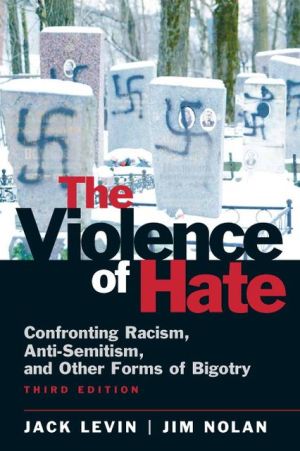The Violence of Hate: Confronting Racism, Anti-Semitism, and Other Forms of Bigotry
Round-the-clock access to reliable content for internet research projects includes thousands of full articles from the EBSCO ContentSelect database, census data from Social Explorer?, daily news feeds from The Associated Press, and primary and secondary source documents from the Pearson bookshelf.\ Step-by-step tutorials present complete overviews of the research and writing process.\ Pearson SourceCheck? offers an easy way to detect accidental plagiarism issues, and our exclusive tutorials...
Search in google:
This text explores two forms of hate and prejudice – racism in contemporary American society and the historical occurrence of anti-Semitism – under a single conceptual framework.Jack Levin, is a well-known scholar, author, and lecturer on the subject of hate crimes. In this book he shows how support for both racism and anti-Semitism can be conceptualized as occurring among four groups: hatemongers, dabblers, sympathizers, and spectators. Levin argues that hate and prejudice continue at a very dangerous level in our society, and that hate typically emanates not from the ranting and raving of a few people at the margins of society, but from ordinary people in the mainstream.Jim Nolan , new to this edition, is an Associate Professor at West Virginia University, and a former FBI agent, specializing in hate crimes and prejudice. Booknews Taking the position that support for racism and anti-Semitism originates in the tacit approval of mainstream society, Levin (sociology and criminology, Northeastern U.) offers a comparative study of hate and prejudice that focuses primarily on racism in American society and anti-Semitism in Nazi Germany. The societal roots of hate are examined in operative and theoretical terms. The way that tacit approval encourages of active bigots is examined and the societal benefits to dominant groups of racism and bigotry are described. Annotation c. Book News, Inc., Portland, OR (booknews.com)
Preface xiChapter 1 Perspectives on Hate and Violence 1Hate, Prejudice, and Discrimination 1Transforming the Terms 1Prejudice Versus Discrimination 2The Role of the Individual 4Hate as a Justification for Violence 5Social Construction of Differences 6When Stereotypes Turn Nasty 9Is Hate on the Decline? 11Underestimating Bigotry 13The Difference Between Small and Insignificant 15Hate Crimes Are Vastly Under-Reported 16It Takes Only a Few Bad Apples 19Threatening Situations Can Inspire Hate 19A Continuing Racial Gap 23The Obama Factor 26Is the Significance of Hate on the Decline? 27The Environmental View 28The Hereditary View 33The Situationist View of Hate and Violence 40Conclusion 44Chapter 2 Hate Crimes 45Motive Matters 45The Hate Crime Statistics Act 46The FBI's Uniform Crime Reporting Program 47NIBRS Hate Crime Data 47Why Now? 51Pros and Cons of Hate Crime Laws 51Hate Crime Laws Today 53Federal Civil Rights Statutes 56New Federal Legislation (2009) 57State Hate Crime Statutes 58Hate Crime Laws and the U.S. Constitution 61Policing Hate Crimes 63Seeing Hate Crimes 66Intension and Extension of the Term "Hate Crime" 67Classification of Hate Crime Incidents 70Why is this Distinction Important? 74Hate Crimes in Europe 75The Roma in Europe 76Sexual Orientation and Gender Identity Violence 77Conclusion 79Chapter 3 A Typology of Hate 81Hatemongers 81The Role of Organized Hate 82Hate from a Distance 83Biblical Bigotry 83The Militia Movement and White Supremacy 85Expanding the Influence of Organized Hate 87Dabblers 90Getting a Thrill 90Being Defensive 93Getting Even 97Sympathizers 99Behind Closed Doors 100An Eliminationist Anti-Semitism 100Cultural Hate 101Culture Transcends Generations 104Spectators 105The Failure to Act 105Middleman Minorities 107Middleman Minorities in the United States 108The American Version of Spectatorship 109Conclusion 112Chapter 4 The Benefits of Bigotry 115Protest by Proxy 122Psychological Advantages 126Enhancing and Protecting Self-Esteem 127Reducing Uncertainty 132Economic and Status Advantages 133Getting the Dirty Work Done 133Eliminating Opponents 136Maintaining Political Power 144Conclusion 145Chapter 5 The Production of Rebels, Deviants, and Other Decent People 147The Power of the Situation 147When Normal People Do Abnormally Nasty Things 147Fighting Spectatorship 149Intergroup Contact 150The Impact of Competition 150Reducing Hostility Between Groups 151Structuring Opportunities for Cooperation 153Follow the Leader 156Obeying Orders 157The Role of Leadership 159The Impact of Deviance 161When Rebels Rebel 162The Importance of Empathy Across Groups 163Human Agency: The Ability to Create "Good" Situations 167The Agentic Perspective 167Collective Efficacy in Neighborhoods 170Neighborhood Agency and Collective Efficacy 170Conclusion 173Appendix A Anti-Hate Websites 175Appendix B Matthew Shepard and James Byrd, Jr. Hate Crimes Prevention Act 177References 189Index 203
\ BooknewsTaking the position that support for racism and anti-Semitism originates in the tacit approval of mainstream society, Levin (sociology and criminology, Northeastern U.) offers a comparative study of hate and prejudice that focuses primarily on racism in American society and anti-Semitism in Nazi Germany. The societal roots of hate are examined in operative and theoretical terms. The way that tacit approval encourages of active bigots is examined and the societal benefits to dominant groups of racism and bigotry are described. Annotation c. Book News, Inc., Portland, OR (booknews.com)\ \








